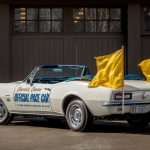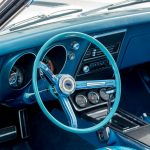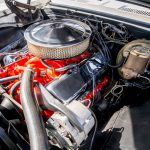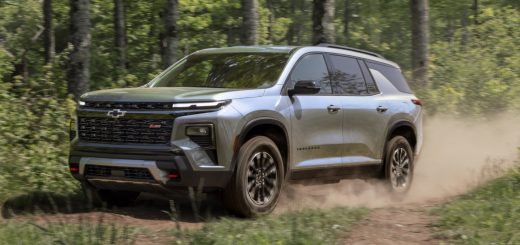The Chevy Camaro debuted for the 1967 model year as a direct competitor for the Ford Mustang. Similar in size, the Camaro was more streamlined than the Mustang and utilized a front subframe for improved ride and noise isolation.
The Chevy Camaro was chosen to pace the 1967 Indianapolis 500. Chevrolet constructed four specially prepared Camaros to handle track duties, along with 100 replica pace cars to be used by race officials and VIPs for the month leading up to the race. The four Camaros built for the race were all Ermine White with Bright Blue interiors and white soft tops, in RS/SS trim, with “Chevrolet Camaro Official Pace Car 51st Annual Indianapolis 500 Mile Race – May 30, 1967” decals on the doors. The nose of the Pace Cars and replicas featured the blue nose stripe and pin stripe as part of the SS package.
Our feature Chevy Camaro is the car that paced the race. It was driven by three-time Indy 500 winner Mauri Rose. It is unrestored, with original paint, interior, and drivetrain installed by GM Engineering. It is one of two cars that were originally equipped with the L78 396 cubic-inch, 375-horsepower Big Block engine backed by a four-speed manual, but converted to an L35 396 325-horse automatic for pace car duties.
The Chevy Camaro Pace Car is in exceptional condition. It shows a bit of patina here and there, but for the most part it is in excellent condition. It appears the odometer has accumulated just over 16,000 miles. The paint shows is surprisingly well preserved, with a bit of orange peel, as it would have had from the factory. The door decals also appear to have survived without cracking. The chrome bumpers and trim show no signs of pitting, and the stainless trim is well polished. The original flags and poles used when pacing the race are in good nick and come with the car.
Inside the Chevy Camaro Pace Car, the Bright Blue vinyl interior has held up well. There are some cracks on the door panel armrests, but the rest of the interior is in very good condition. Special chrome passenger grab handles were installed as part of the Pace Car modifications, and these are still in place. The soft top parade boot had different snaps installed, and these also remain. There is a bit of crazing on the steering wheel horn button.
Under the hood of the Chevy Camaro resides the 396 Big Block swapped by GM Engineering, complete with block and heads stamped with the GM Engineering mark. The engine bay is tidy, appearing to have been detailed. The valve covers and air filter cover are chrome, and the block is painted standard Chevy orange. The power brake booster is present on the firewall, and the battery is a period-correct replica.
For years after this Chevy Camaro Pace Car’s duties were finished, it was on display at Dan Young Chevrolet in Tipton, Indiana, or at the Indianapolis Speedway Museum. The Camaro is accompanied by the Protect-O-Plate and Chevrolet Build Order No. 98168 document the change, the original title issued to Chevrolet Motor Division in 1967, GM Engineering paperwork itemizing all the changes made to the car, the cover of the official Chevy Indy Pace Car book, a five page article in the Complete Book of Chevrolet, pictures from the race.
This historic 1967 Chevy Camaro Pace Car will cross the auction block at the Mecum Indianapolis, Indiana sale May 13th through the 21st.
Be sure to subscribe to GM Authority for more Chevy Camaro news, Chevrolet news and unrestricted GM news coverage.






































Comments
What happened to the original pace car that was given to the race winner?
From the listing: “Interestingly, this car was intended to be presented to the winner of the 1967 Indy 500, A.J. Foyt, who won the race driving a Ford-powered Coyote. As it turned out, Foyt actually declined to accept the car. The official reason was because it was not equipped with air conditioning or a power top. The more likely reason was that he didn’t want to upset his sponsor, Ford Motor Company, by accepting the new competitor to Ford’s Mustang.”
Thanks for your response, Brett. Do you know what happened to the car you’re talking about? Also, what listing are you referring to?
Click the link to the auction listing at the bottom of the page.
What was the reason to go from the 375 to 325 horse 396? The Automatic could be rationalized…..wonder why they didn’t just build it out with the powertrain that they would use……….